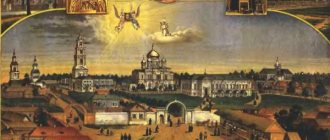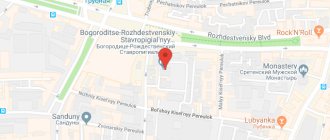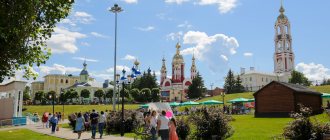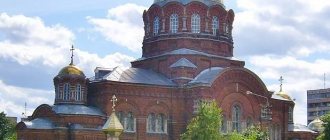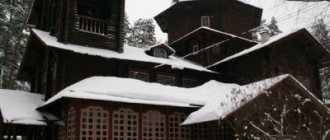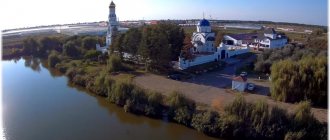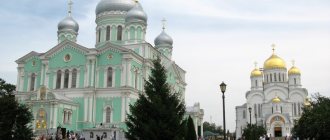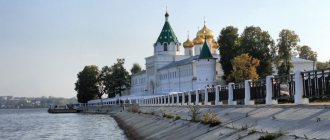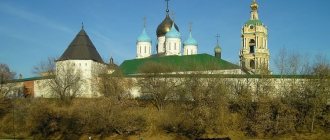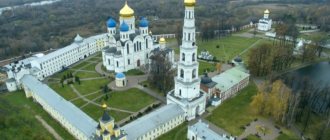| Holy Trinity Seraphim-Diveevo Convent |
Seraphim-Diveevo Convent in the Name of the All-Holy Trinity
of the Nizhny Novgorod Diocese
- Address: Russia, 607320, Nizhny Novgorod region, Diveevsky district, village. Diveevo
- Tel.: +7 (83134) 4-34-45
- Official site:
- Yandex.Map, Google map
Formation of a community
The monastery was founded in the second half of the 18th century by the Venerable nun Alexandra (Melgunova), who was a wealthy landowner in the world. The Mother of God Herself commanded her to become the founder of the new, fourth, inheritance of the Mother of God on earth
(after Iberia, Athos and Kiev). Around 1760, the ascetic stopped in the village of Diveevo, where she received a miraculous notification that this was the place chosen by the Most Pure One. In 1767, at the expense of the saint, a stone church was founded in honor of the Kazan Icon of the Mother of God. The main altar was consecrated in 1772, the left chapel in the name of St. Nicholas the Wonderworker - four years later, and the right chapel in the name of the first martyr Archdeacon Stephen - in 1779 [1]. From Kazan the saint brought an exact copy of the icon of the Kazan Mother of God, from Kyiv - particles of holy relics, from Moscow - bells, and from the Sarov Monastery - an old iconostasis. In 1788, the local landowner Zhdanova, having heard about the monastery promised from above to Mother Alexandra, donated 1,300 square meters. fathoms of his estate land near the Kazan Church for the establishment of a community. The Monk Alexandra built three cells there and surrounded the buildings with a wooden fence. She occupied one cell with a novice, invited three more novices to live in another, and gave the third to pilgrims going to Sarov. The community lived according to the strict Sarov charter. The mentor of the sisters was the Sarov elder Pachomius. Food was brought once a day from the Sarov meal. The sisters sewed and knitted for the Sarov brethren, and led a non-covetous life of labor and prayer. Before her death in 1789, Mother Alexandra asked the young hierodeacon of the Sarov Hermitage, the future Venerable Seraphim, to take care of her community.
After the death of the founder of the community, the young monastery was headed by one of the three remaining sisters, Anastasia Kirillovna, who over the course of seven years gathered up to 52 sisters into the community. Since 1796, after the death of Anastasia Kirillovna, the community was headed by Ksenia Mikhailovna Kocheulova. She was so strict that in the first year of her administration, 40 people left the community, but then new ones began to arrive.
The Monk Seraphim of Sarov wanted to soften the severity of the charter of the Kazan community, but Mother Ksenia did not agree, saying that the charter was given by the Sarov builder Pachomius. Then, in 1826, at the direction of the Mother of God, Saint Seraphim established another community near the Diveyevo Kazan community, which received the name “Melnichnaya,” with a softer charter. The founding day of this monastery is considered to be December 22 of that year. According to the instructions of the Most Pure One, eight sisters from the Kazan community should have been transferred to it. It was ordered to build two churches - in honor of the Nativity of Christ and the Nativity of the Blessed Virgin Mary, to dig a ditch and pour a rampart around the monastery, and also to build a feeding mill.
After the repose of St. Seraphim, the abbot of the Trinity-Sergius Lavra, St. Anthony (Medvedev), took over the care of the Diveyevo community. In 1842, the Mill community was annexed to the Kazan community.
The heyday of the monastery
On February 10, 1861, by decree of the Holy Synod, the Diveyevo women's community was elevated to the level of a third-class dormitory monastery. The charter of the monastery was taken from the Melnichnaya community, which is why the monastery began to be called Seraphim-Diveevsky. During the years of management of the monastery by Abbess Maria (Ushakova), the monastery acquired its unique architectural appearance, which was preserved at the beginning of the 21st century. The Trinity Cathedral predicted by St. Seraphim (1875), the abbot's building (1885) with the Church of Equal-to-the-Apostles Mary Magdalene (1901), the refectory church of the blessed Prince Alexander Nevsky (1895), the bell tower (1902) and about 30 buildings for obediences and housing for sisters.
The main income of the monastery came from numerous workshops: handicrafts, where they embroidered with gold and silk, as well as satin stitch on cambric and linen, painting, lithography, where they also engaged in photography and metachromotyping (translating engraved paintings onto tin, stone and wood), metal carving and bookbinding business. The monastic needs were provided by bread, prosphora, candles, tailoring, vestments, and manate [2] obediences. The scroll shop sewed scrolls (shirts) for the Sarov brethren, up to 400 pieces annually. Many buildings were occupied by economic departments: glass, painting and painting, cellar, vegetable gardening, gardening, milling. The monastery had a large orchard. There was a threshing building and two granaries. The meal, prosphora and almshouse were supplied with water from a pumping station, which supplied the entire monastery and two baths with the required amount of water.
Separate buildings housed an almshouse for seriously ill and elderly sisters, a dental office and a hospital. At the monastery, a shelter was set up for girls, mainly orphans, where they were taught by priests, and the sisters of the monastery taught needlework and sacred singing. Outside the fence, the monastery owned hotels (both for nobles and common people), a horse yard with the necessary buildings: a forge and two huts for workers, as well as five houses for priests and deacons with outbuildings and a garden.
By the beginning of the century, the Seraphim-Diveevo Monastery had become the largest monastic hostel. On August 2, 1903, during the Sarov celebrations on the occasion of the glorification of St. Seraphim, the monastery received the passion-bearers of Emperor Nicholas II with Empress Alexandra Feodorovna and members of the royal family. The following year, after the death of Abbess Maria, on her instructions, the sisters elected nun Alexandra (Trakovskaya) as Abbess Treasurer, who remained the abbess of the monastery until its closure.
Closure and ruin
In 1919, the monastery was transformed into a labor artel. Divine services in churches still continued, but lands, farms and farms were confiscated. The sisters had to bear labor obligations: work on nationalized land, receiving rations for it. The closure of the Seraphim-Diveevo Monastery followed on September 27, 1927.
During the years of Soviet power, many monastery buildings were destroyed, the Holy Kanavka was covered with earth and debris.
Renaissance
The revival of church life in Diveyevo began in 1988, when believers were allowed to buy a house above the Kazan spring and rebuild it for a church. On Lazarus Saturday, April 22, 1989, the wooden church was consecrated in honor of the Kazan Icon of the Mother of God. On April 31, 1990, on the day of the Praise of the Most Holy Theotokos, the Trinity Cathedral was re-consecrated. From January 1, 1991, all statutory services began to be held there daily.
On July 18, 1991, the Holy Synod decided to renew the Seraphim-Diveyevo Monastery [3]. On July 30 of the same year, the newly discovered holy relics of St. Seraphim of Sarov solemnly arrived in Diveevo.
Statistics
- 1796 - 52 sisters [4]
- 1825 - 50 sisters [4]
- 1833 - in the Mill community: 19 cells, 73 sisters [4]
- 1917 - according to the list: 270 nuns, 1474 novices (while the population of the village of Diveevo was 520 people) [4]
- OK. beginning 2000s - more than 400 nuns [5]
- OK. con. 2010s - in the monastery and on its 19 hermitages and farmsteads: 36 churches with 82 altars; OK. 500 nuns [6]
| Trinity Cathedral of the Seraphim-Diveevsky Monastery |
History of the formation of the monastery
The monastery chronicle contains the history of its existence, which tells that the founder of the monastery was the noblewoman Agafya Semyonovna Melgunova (nee Stepanova). Having become a widow early, she and her three-year-old daughter went to Kyiv, to the Florovsky Monastery.
Takes monastic vows under the name Alexandra. In a vision, the Mother of God blesses mother to travel in search of a holy land to found a monastery. In the village of Diveevo, the Mother of God indicates that the place has been found.
Having lost her only daughter, Alexandra heads to her native land. Sells estates, releases serfs. By 1767 he returned to Diveevo. Having built a cell in the courtyard of priest Vasily Dertev, she begins a new life, entirely devoted to the service of the Mother of God.
Mother Alexandra erects a stone temple in the name of the Kazan Mother of God on Diveyevo land to replace the dilapidated building of the Church of St. Nicholas the Wonderworker. Later, next to the church, a women’s community is established, which lives according to the difficult rules of the Sarov monastery.
On June 13, 1879, the founder died. First Father Pachomius took charge of the women's monastery, then Seraphim of Sarov.
Since 1825, Father Seraphim has been establishing a new Seraphim community. The community lives according to the charter, which the Mother of God gave, telling it to St. Seraphim. A windmill - a feeder - is being built here. In 1829, Seraphim blesses the sisters for digging the Mother of God ditch, which is now a place of pilgrimage for pilgrims.
In 1829, the Church of the Nativity of Christ was added to the Kazan Church. In 1830, a temple was built under it in honor of the Nativity of the Virgin Mary, which became the place of worship for the sisters of both women's communities: Kazan and Melnichnaya Seraphimo-Diveevskaya.
After his death, landowner Nikolai Aleksandrovich Motovilov becomes the breadwinner of Seraphim’s community. Father Seraphim heals him, who is seriously ill. The elder bequeathed to him to take care of the Diveyevo sisters and serve the monastery.
The Diveyevo monastery becomes widely known, where widows and girls from various parts of Russia come to live. In 1842, the communities united into one - Serafimo-Diveevskaya.
From 1848 to 1875, the stone five-altar Trinity Cathedral was built here. The territory is being improved. By the beginning of the 20th century, the following were operating in the monastery: the Trinity Cathedral, the Nativity and Tikhvin churches, the Preobrazhenskaya church in the cemetery, house churches in the Igumensky, Refectory, and Almshouse buildings.
Photo of the Diveyevo Monastery of Seraphim of Sarov during the Tsar’s visit
During the revolutionary years, a labor artel was opened on the territory of the monastery. In 1927, the monastery was closed, desecrating the temples. The famous Kazan Church is closed after 10 years.
The revival of the monastery began in 1990. Trinity Cathedral is consecrated. In 1991, the grave of Mother Alexandra was restored and the relics of Seraphim were transferred to the cathedral. Alexandra's relics were transferred to the Church of the Nativity of the Virgin Mary in 2000. The Diveyevo Monastery of Seraphim of Sarov begins to operate, multiplying the power of Orthodoxy.
Transfiguration Cathedral
The cathedral was founded in 1907.
In 1916, construction was basically completed: the iconostasis and the necessary utensils were ready, but there was no heating.
After the revolution of 1917 during the years of Soviet power, it was a garage, then a shooting range. The words of Blessed Praskovya Ivanova, said during the laying of the stone, are considered to be an omen of what happened in the Soviet years: “The cathedral is a cathedral, but I saw that bird cherry trees had grown in the corners of the cathedral, as if they had not blocked it.”
In 1991, the cathedral was transferred to the revived monastery. The restoration continued for several years. Photographs of the destroyed Transfiguration Cathedral, as well as other churches of the monastery, can be seen on a memorial plaque near the Church of the Nativity. The consecration of the main altar took place 91 years after the start of construction - on September 3, 1998, in honor of the Transfiguration of the Lord. On October 27, Metropolitan Nicholas in honor of St. The southern aisle was consecrated by the Archangel Michael of God with all the ethereal Heavenly Powers. Previously, in honor of St. One of the chapels of the now defunct Tikhvin Church was consecrated to the Archangel Michael of God. The painting of the limit was carried out in 2005 under the leadership of Anatoly Belyaev.
The cathedral contains the relics of the Venerable Martha of Diveyevo. Her relics were found after her glorification as a locally revered saint on December 22, 2000. Remembrance Day is celebrated on September 3. According to Seraphim of Sarov, the Monk Martha is the superior of the Diveyevo sisters in the Kingdom of Heaven.
The cathedral also houses the relics of Blessed Paraskeva (Pasha of Sarov). The saint's memorial day is celebrated on October 5. It is believed that the blessed one predicted the death of the Romanov dynasty, persecution of the Church and a sea of blood.
In 2003, the graves of the cathedral's temple creator Fyodor Vasilyevich Dolgintsev and his wife Ekaterina Ivanovna were restored.
According to established tradition, the main service for the Dormition of the Mother of God is held in the cathedral.
Diveyevo Monastery today
Diveevo amazes with its beauty, inspires with its history, and with the presence of the grace of the Holy Spirit. The abbess of today's monastery, Abbess Sergius, notes that at present everything here has been restored spiritually as in the old days.
Churches were restored, monastery buildings were repaired, the Holy Kanavka was dug up. The plan of the monastery, drawn by the hand of Father Seraphim, miraculously coincides with today’s layout of churches. This is clearly visible from a bird's eye view. Kazan Cathedral, Bell Tower, Trinity, Transfiguration, Annunciation Cathedrals are built in one line.
20 hermitages and farmsteads appeared. Here the relics of the blessed ones found peace - Praskovya, Pelageya and Mary, the nun Matrona. Through the efforts of the nuns of the icon-painting workshop, the walls of the Kazan, Transfiguration, and Trinity cathedrals were painted. New buildings were built: church shops, religious kiosks, refectories, buildings for pilgrims.
Seraphim revered earthworks. Hectares of the monastery land are decorated with flower beds. Numerous fruit trees and berry bushes grow and bear fruit. Vegetables are grown in the gardens. More than 500 sisters work in the monastery. Their life is spent in worship and obedience.
What time to visit the monastery
People rush to the shrines at the call of their hearts exactly when they should be here. The timing of the trip is also chosen based on priority desires. The nature of the monastery reflects the natural beauty of all seasons. Therefore, you can opt to visit the monastery during your favorite season.
From May to September the opportunity to swim in healing springs is added. The mildest months for this are May and September. In May, mosquitoes appear near the water, people stock up on protective equipment. If it is more important to take part in special events or memorable ones, get acquainted with the Orthodox calendar in advance.
The monastery is crowded on weekends and church holidays. Therefore, it is better for those who like less crowds to visit the days when multi-day fasts take place. During such periods, fewer festive events are held, and the influx of pilgrims decreases accordingly.
There is less influx of people, slightly lower prices, discounts and promotions are organized more often in the winter months. The exception is during the New Year holidays.
How to get to the Diveyevo Monastery of Seraphim of Sarov
The Diveyevo Monastery of Seraphim of Sarov is located in good transport accessibility. It can be reached by various transport from Moscow, Nizhny Novgorod, Arzamas.
From any airport in Moscow, planes deliver tourists in 1 hour to 1 hour 15 minutes to Strigino Airport in Nizhny Novgorod. By train they travel from Moscow railway stations - Yaroslavsky, Kursky to the Moscow railway station in Nizhny Novgorod. More than 20 trains depart during the day. Direct and passing flights. Travel time – from 5 hours 17 minutes to 7 hours 13 minutes.
6 direct flights of the Strizh and Lastochka trains depart from Kursky Station daily. Travel time – 3 hours 47 minutes – 4 hours 13 minutes.
Private bus transportation on the route Moscow - Nizhny Novgorod is also organized by the Passenger company of the city of Sarov, individual carriers. Travel time is up to 7 hours. A similar travel time takes a trip from Moscow to the village of Diveevo using your own transport.
Transport campaigns “Fellow Traveler” and “Passenger” of the city of Sarov organize bus transportation from the city of Nizhny Novgorod to the village of Diveevo. Travel time is 3 hours. By your own car, you can get along this route in 2 hours 15 minutes.
You can take a passing flight from the city of Moscow from the Kursk railway station to the city of Arzamas. Travel time can last from 5 hours 58 minutes to 6 hours 50 minutes. From Arzamas to Diveyevo you can get there by bus from the “Helper Traveler” campaign or by your own car in 1 hour 30 minutes.
Miracles of St. Seraphim of Sarov
In 1993, a pilgrim from Tashkent came to the Diveyevo Monastery. The man had a long-healing wound on his arm. After venerating the relics of St. Seraphim of Sarov, the wound began to scar. Soon she completely healed.
In 1999, a woman, Elena, came from Samara to the Diveyevo Monastery, who, having been married for a long time, had no children. She prayed for a long time at the relics of St. Seraphim of Sarov for the gift of a child. Exactly a year later, her son was born.
Read us conveniently on social networks:
Tags: where is Diveevo located, Diveevo monastery, Diveevo monastery where is it located, Diveevo Nizhny Novgorod region, Diveevo monastery
Where to stay in Diveevo
Everyone can find here a place to relax and spend the night in accordance with their income level. A cheaper option is accommodation in the private sector. There are a number of advertisements on the Internet for rooms, apartments, and houses for rent.
Addresses are also located in the pilgrimage center. Lovers of rural life choose just such housing. But there is deception in advertisements when the conditions provided do not coincide with the stated ones. A minimum of amenities is possible, sharing and living with owners of different behavior and lifestyles.
Campaign “House in Diveevo”, located at the address: lane. Golyakova, house 2, helps to rent an apartment, housing in the private sector.
Pilgrims who want to stay near the monastery choose pilgrimage buildings. There are 17 of them. They settle here only through the pilgrimage center. For registration, provide a passport with a registration mark or a driver's license.
Reservations are possible 2 months before your arrival date. The rooms are comfortable, with amenities. Single travelers settle here. Living as a family is impossible, since men and women live separately. You can stay in the village of Diveevo in hotels, there are more than 20 of them.
Among tourists, the following are rated higher:
- apartments – “On Komsomolskaya street, 9”, “On Rossiyskaya, 2”,
- guest houses “Visit”, “Izumrudny Bereg”, “Blagovest”, “On Vostochnaya 1d”, “On Vostochnaya 27”, “On Parkovaya 34”, “Radonezh”,
- mini-hotel "Moskovskaya",
- hotels “Valentina”, “Planet”, “Svetoch”,
- hotel complex "Olympus".
Booking possible without a credit card, free WI-fi. The cost of one night for an adult will be from 1000 to 4700 rubles. During major festivals and celebrations in the summer, 2-3 tent camps with a field kitchen are set up. Pilgrims live here, private guests and excursion groups can be accommodated.
Where to eat in Diveevo
Free meals are provided on the territory of the monastery, in the refectory, using coupons purchased at the pilgrimage center. The dishes are simple: vegetables and porridge. During the holidays they add homemade cheese, sour cream, and honey.
Lunch is served from 11.00 to 13.00, dinner from 20.00 to 21.00. The monastery refectory is located in the Alexander Nevsky Church on the ground floor. In summer - next to the Museum of Blessed Paraskeva.
There are paid cafes on the territory of the Seraphim of Sarov Monastery. There is a canteen in the Pilgrim's House. Dishes are prepared lean, meatless, without meat. In the monastery food places, prices are slightly lower than in the village itself.
In Diveevo, food intake points are often located at guest houses and hotels:
| Name | Menu |
| "Hunting Lodge" Cafe. Pl. Blagoveshchenskaya, building 1. At the Diveevskaya Sloboda hotel complex. | Meat dishes, Japanese cuisine. |
| "Expanse". Cafe. Pl. Blagoveshchenskaya, building 1. At the Diveevskaya Sloboda hotel complex. | Russian kitchen. Buffet/set menu. Homemade bread. |
| "Raspberry ringing" Restaurant at the Diveevskaya Sloboda hotel complex. Pl. Blagoveshchenskaya, building 1. | Dishes from Russian and European cuisines. |
| Cafe "Olympus". St. Arzamasskaya, house 1/2. At the Olympus hotel complex. | Dishes from Russian and European cuisines. For pilgrims - a Lenten menu. |
| Cafe "Valentina". St. Stroiteley, house 2A/1. At the Valentina Hotel. | Russian kitchen. Bakery. Set lunches. |
| Cafe at the Zarechnaya Hotel. St. Polevaya, house 2. | Russian kitchen. On fasting days, lenten dishes are prepared. |
| Cafe at the Moskovskaya Hotel. St. Shkolnaya, house 5B. | European cuisine. |
| "Diveevo NB", cafe at the hotel. St. Komsomolskaya, 4. | Dishes of European and Russian cuisines. Complex meals are offered for tourists. |
| Cafe "Kameya". St. Arzamasskaya, house 49B. | Russian kitchen. Natural Turkish coffee. Blessed salt and spring water are used in dishes. |
| Cafe "Hotel complex "Russian Troika". St. Oktyabrskaya, house 34/1. At the Russian Troika hotel complex. | Russian kitchen. On fasting days, lenten dishes are prepared. Complex meals are offered for tourists. |
| Cafe "Veranda". St. Truda, house 5. | Russian and international cuisines. |
| Coffee shop on Arzamasskaya. St. Molodezhnaya, building 52. | They serve coffee of various varieties, types, pastries, sandwiches, dumplings. |
| Cafe "Pelmennaya". St. Mira, building 1A, shopping center "Crystal", 3rd floor. | Homemade Russian cuisine. |
Don't miss the most popular article in the section: Metro Nizhny Novgorod. Diagram, map, description.
Diveyevo Convent: infrastructure
The Holy Trinity Seraphim-Diveevo Convent is located in the large beautiful village of Diveevo, where the infrastructure is well developed. Here you can always find accommodation for every taste and for any time.
Public transport is available and good food is provided. The village has shops, a pharmacy, a hospital, numerous cafes and restaurants, a canteen, and a Sberbank branch.
Visiting pilgrims often eat in the Orthodox monastery refectory. The food there is lean and lacks variety. Having arrived at the place, you can rent an inexpensive room from local residents. The price per night is 400-500 rubles per person, or even less.
Trinity Seraphim-Diveevo Convent
The Diveevo Convent is a special world. At the entrance to it there is a Pilgrimage Center. It is possible to stay there for the night or stay if you have an identity document - a passport or driver's license.
The schedule of the Diveyevo Convent can be seen at the entrance. It is open to the public from 5 a.m. until late in the evening. At 23:00 its gates are closed for the night.
All pilgrims know how to behave correctly in the Holy Monastery. Well, those who come on an excursion need to understand that foul language, smoking and alcoholic drinks are strictly prohibited here.
There is a sense of calm and a kind of prayerful silence in the monastery. At the same time there are crowds of people around. You should behave quietly so as not to disturb the monastic way of life.
From the video you will learn everything about the Diveevo Convent
Useful tips for pilgrims and tourists
When planning to visit the Diveyevo Monastery, take with you:
- containers for collecting water from 6 healing springs;
- bags for folding wet clothes after swimming;
- towel;
- packaging for soil from the groove, crackers;
- bottle for oil.
Car parking is available in the free parking lot to the right of the main entrance to the monastery. They also park on the side of the road directly along the road along which they go to the monastery.
The rules of behavior on the territory of the Seraphim of Sarov Monastery are presented on a poster that greets you at the entrance.
Silence is maintained here. Gadgets are put on silent mode or turned off. Maintain cleanliness and routine, do not smoke or drink alcohol. Children visit the monastery only with adults.
Women visit the shrine wearing a skirt or dress. Length – below the knees, sleeves covering the elbows. The head must be covered. Bright makeup and jewelry are not allowed. Men are allowed to visit in trousers and shirts. Baptized people must wear a cross.
When performing services, they do not go to churches. They stand and, if desired, quietly sing along with the choir. The sick and weak sit on benches.
They take photographs and film for free on phones and tablets. Filming with video cameras and cameras is carried out by purchasing a coupon at the pilgrimage center. Journalists and film crews must purchase permission for professional work from the press service of the Nizhny Novgorod and Arzamas diocese.
People approach shrines with prayer. They cross themselves at the holy relics, bow twice, venerate, then bow again. People do not linger long at the shrines to which people stand in line.
Holy places of the Diveyevo monastery
Trinity Cathedral is a magnificent sanctuary. It was built on the site chosen by Father Seraphim himself. The architecture is similar to the Moscow Cathedral of Christ the Savior. The developer is architect Alexander Ivanovich Rezanov.
4 chapels are consecrated in honor of: the icon of the Mother of God “Tenderness”, the Mother of God of Vladimir-Oran, Seraphim of Sarov, the third finding of the head of John the Baptist.
In the temple, the elder prayed and died at the miraculous image of “Tenderness.” Its copy, made at the beginning of the 20th century, is in the cathedral. Since 1991, divine services have been held in the Trinity Cathedral every day. The relics and personal belongings of the saint rest here. Access to the relics and things of the elder is open daily from 5.00 to 20.00.
The Transfiguration Cathedral was founded on the same line as the Trinity Cathedral in 1907. The sisters painted it with their own hands. Construction was not completed before the revolution. Preobrazhensky was restored in 1991 and consecrated 7 years later. The temple is directed upwards and is distinguished by its lightness.
There are 5 limits in it, which are consecrated in honor:
- Feast of the Transfiguration of the Lord;
- All Saints;
- icons of the Mother of God "Tikhvin";
- New Martyrs and Confessors of the Russian Church;
- Archangel Michael and all the powers of heaven.
Divine services are held daily.
The Church of the Icon of the Kazan Mother of God is elegant thanks to the Russian Baroque architectural style. The monastery began with her. Founder Alexandra founded it in 1773, completing construction in 1779.
The church was consecrated by Hieromonk Pakhom in 1780. At that time, the church had 3 altars, consecrated in honor of St. Nicholas, the martyr Stephen, and the icon of Our Lady of Kazan. In the 20th century, bell towers, bells, domes, and crosses were removed and destroyed.
The year the church was returned to the monastery was 1992. In 2003, the bell tower was renovated, crosses and a dome were erected on it. In 2004, the bells were consecrated and erected, the main one of which is decorated with images of saints. In the same year, the main altar of the revived temple was consecrated with celebrations. Famous artists and carvers decorate the interior.
Eight new chapels were built in 2007, and a year later they were consecrated. The church is being elevated to the status of a cathedral. Here are the holy relics of blessed Pelageya, Maria, Paraskeva, and the nun Matrona.
The Holy Kanavka , which begins behind the altar of the Transfiguration Cathedral, is a unique shrine. Fulfilling the behest of the Mother of God, Seraphim instructed the sisters to dig a ditch for the community. The appearance of the spirit of Seraphim accelerated the work. In 1833, after 3 years of hard work, the Ditch was dug. In 1927 it was completely filled up. Later communications were laid.
Only since the beginning of 1991 have nuns revived their daily walk along the Holy Kanavka.
In 2006, the complete resurrection of the shrine was completed, exactly according to the legends of Seraphim of Sarov. The shape is a heptagon with a perimeter of 775 m. The ditch is surrounded by a high shaft. Grass, flowers grow along its slopes, and berry bushes bear fruit. This is a place for quenching sorrow, filling the heart with special joy. Seraphim bequeathed to pass here and read the prayer to the Mother of God 150 times.
The hermitage of the blessed Paraskeva is filled with grace - a house-museum where the spirit of holy antiquity is preserved. It was opened in 2004. A significant exhibition tells about the history of the monastery.
A large number of rare shrines are collected here: the true things of Seraphim, ancient handwritten notebooks of Diveyevo elders with records of his life, portraits of Diveyevo monks, clergy, icons. Also on display are portraits of benefactors, Abbess Maria, her seal and autograph.
Interesting things from the sisters' everyday life:
- watch;
- dishes from the abbot's chambers;
- monastic robes;
- harmonium;
- sisters' handicrafts;
- synodics;
- present;
- chests of drawers;
- sofas;
- carpets;
- blankets
Seraphim's cell was restored. With the caring hands of the nuns, their and the elder’s belongings were laid out just as they were during his lifetime. One of the exhibitions reflects the celebrations on the occasion of the discovery of the relics of the saint.
The final composition is the blessed cell, in which everything has been restored as it was during life. It is remarkable that Paraskeva received Tsar Nicholas II and the Empress in her cell. Here is a lithographic portrait of the king.
There are many icons in the house. The blessed one, playing with dolls, predicted, exposed vices, and helped in resolving life's difficulties. That’s why there are old dolls in the cell. Paraskeva's things have reached us: a shirt and dress, photographs of the doll and the blessed one, a lock of hair, a bookmark, a comb, a piece of canvas. The sacred spirit from the presence of many holy people, Paraskeva makes this place special.
Modern life of the monastery
The revival began in 1988, when the church parish was registered. On April 22, 1989, Archbishop Nicholas of Gorky and Arzamas consecrated a wooden church in honor of the Kazan Icon of the Mother of God. For this purpose, in January, a wooden house on the outskirts of the village, next to the Kazan spring, was purchased from the relatives of the last priest. Before the closure of the monastery, this house stood not far from the Holy Kanavka and there was a candle workshop of the monastery in it. Then the building was dismantled and moved to the outskirts to provide housing for priests who were evicted from the center of the village. An altar was added to the purchased house and a wooden bell tower was built. The consecration of the church took place on Lazarus Saturday and coincided with the day of remembrance of the last Diveyevo priest, John (Smirnov). Before the consecration, a full-length icon of Seraphim of Sarov was brought into the church with the saint’s half-mantle attached.
In October 1989, Trinity Cathedral was transferred to the church community. In the spring of 1990, with a rainbow shining in the clear sky, a cross was placed on it. The consecration of the Trinity Cathedral took place on March 31, 1990 by Archbishop Nicholas. On August 1, the chapel in honor of the Icon of the Mother of God “Tenderness” was re-consecrated.
On July 21, 1991, the Holy Synod decided to renew the monastery.
On July 31, 1991, the relics of St. Seraphim of Sarov, rediscovered in St. Petersburg in the Kazan Cathedral, which was then the Museum of Atheism and Religion, solemnly arrived in Diveevo.
On November 17, 1991, Metropolitan Nikolai (Kutepov) of Nizhny Novgorod and Arzamas ordained nun Sergia (Konkova), who had previously served as dean in the Spaso-Preobrazhenskaya Hermitage of the Riga Monastery, to the rank of abbess of the monastery.
In April 1992, according to the behest of Seraphim of Sarov, an unquenchable candle was lit in front of the image of the Savior in the Church of the Nativity. In July, the building of the Kazan Church was transferred to the monastery. On October 21, the Church of the Nativity of the Virgin Mary attached to it was re-consecrated. In September, the Nikolsky monastery in Avtodeevo was transferred to the monastery, and on December 25, the territory of the former Kutuzovsky monastery was transferred.
On June 1, 1993, the Church of the Nativity of Christ was re-consecrated. In the lower Church of the Nativity of the Virgin Mary in 1993, the first monastic tonsure took place after the opening of the monastery.
On February 20, 1995, by presidential decree, the Kazan Church was given the status of an architectural monument of federal significance.
In the summer of 1996, the facade was repaired and the dome over the house church in the name of St. Equal-to-the-Apostles Mary Magdalene was restored. On September 27, on the Feast of the Exaltation of the Holy Cross, a cross was installed on the dome. Since 1997, work began inside the church. In 1996, a comprehensive monastery Orthodox school was opened.
On September 26, 2000, the relics of Saints Alexandra, Martha and Elena Diveevsky were discovered. On December 22, they were glorified as locally revered saints of the Nizhny Novgorod diocese. Also in 2000, research began in 1997 to determine the condition of the Kazan Church was completed.
In 2002, the foundations of several chapels were laid next to the restored Kazan Church, but then their construction was suspended until the completion of the main building, restoration work on which began in 2003.
Blessing of the procession with the relics of Seraphim of Sarov
In 2003, the 100th anniversary of the canonization of Seraphim of Sarov was celebrated. The services were led by His Holiness Patriarch Alexy II, and among the guests and pilgrims was the future Patriarch, Metropolitan Kirill.
In July 2004, Kursk celebrations took place. On July 20, after the Divine Liturgy in the Trinity Cathedral, the holy relics of St. Seraphim of Sarov were transferred to the bell tower. Then they were taken to Sarov airport by a specially prepared car. Next, by An-26 aircraft of the Russian Navy on the route Sarov - Penza - Voronezh - Kursk. After the prayer service on the airfield, the religious procession to Red Square in Kursk began. In 3 hours 11 km were covered. During this time, the bishops consecrated a chapel in honor of Seraphim of Sarov near the Sergius-Kazan Cathedral, built in the 18th century by the Rev.’s parents, Isidore and Agafya. The bishops greeted the religious procession near the Resurrection and Elijah Church in which the parents were married and the future elder was baptized. After which the procession proceeded to the restored Znamensky Cathedral, where in three days from 130 to 150 thousand people venerated the holy relics. On July 23, the relics were delivered by plane to Sarov, from where on the same day they were transported to the Diveyevo Monastery.
On July 31, 2004, celebrations dedicated to the 250th anniversary of the birth of St. Seraphim of Sarov began. On this day, Metropolitan Philaret of Minsk and Slutsk performed the rite of the Great Consecration of the Kazan Church, restored in 2004. The building of the new school was also consecrated, and the building of the old one was transferred to the monastery. On the same day, July 31, 2004, Blessed Elder Maria Diveevskaya was glorified among the locally revered saints of the Nizhny Novgorod diocese. Her holy relics were found on September 14, and in October her church-wide veneration began. Since the discovery of the blessed power they have been in the Kazan Church. The Soviet government prohibited visiting the blessed one; communication with her took place secretly, through notes. She predicted camps and exile for the sisters and the subsequent revival of the monastery.
In the summer of 2004, during the construction of the chapel, the sisters of the monastery discovered the foundation of a mill, the foundation of which marked the beginning of the girls’ community.
On September 8, 2004, Bishop George performed the rite of the Great Consecration of the southern chapel of the Church of the Kazan Icon of the Mother of God in the name of the Holy Proto-Martyr and Archdeacon Stephen. Representatives of the Romanian Orthodox Church were present at the consecration ceremony. On October 17, the Bishop consecrated the St. Nicholas chapel.
On July 31, 2005, the celebrations began with Little Vespers in the Trinity Cathedral. On this day, 5 religious processions came to the monastery: from Nizhny Novgorod, Arzamas, Sarov, Pavlov and Ardatov. Believers from Nizhny Novgorod walked more than 200 km in 12 days.
On February 3, 2006, Bishop George of Nizhny Novgorod and Arzamas performed the rite of the Great Consecration of the Church in the name of the Holy Equal-to-the-Apostles Mary Magdalene.
On July 31, 2006, Little Vespers in the Trinity Cathedral was performed by His Holiness Patriarch Alexy II, who led the celebrations dedicated to the 300th anniversary of the Sarov Desert.
In April 2007, work on the construction of eight chapels of the Kazan Church was resumed. The design of the architect Viktor Koval was taken as a basis. By September, construction work was completed.
With the blessing of Patriarch Alexy II, the relics of Reverend Confessor Matrona (Vlasova) were found in September 2007. After finding her relics, they were in the house church of Equal-to-the-Apostles Mary Magdalene.
In April 2008, the remains of the third abbess of the Kazan community, Ksenia Mikhailovna Kocheulova, were reburied.
In 2008, 5 more chapels of the Kazan Church were consecrated: on July 20 - in honor of the holy martyr Seraphim (Chichagov), compiler of the "Chronicle of the Seraphim-Diveevsky Monastery", on August 21 by Bishop George - in honor of the holy wives of Diveyevo Martha, Elena and Alexandra, on October 2 - in honor of the Diveyevo ascetics and prayer books, the venerable martyrs Martha and Pelageya (Testovs) and the venerable confessor Matrona (Vlasova). Archbishop George consecrated the chapel in honor of the holy Royal Passion-Bearers on December 3, and on December 11 the chapel was consecrated in the name of the holy blessed Diveyevo Pelageya, Maria and Paraskeva.
On January 17, 2009, Vladyka consecrated the sixth chapel in honor of the Venerable Martyr Evdokia (Shikova) and her novices: Daria (Timolina), Daria (Siushinskaya) and Maria, who accepted martyrdom on the eve of the Feast of the Dormition of the Mother of God in 1918.
On July 22, 2009, during a visit to the monastery, President Medvedev presented an icon of the holy great martyr and healer Panteleimon.
On September 9, 2009, on the eve of the visit of the Patriarch of Moscow and All Rus' Kirill, Archbishop George of Nizhny Novgorod and Arzamas celebrated the Divine Liturgy at the Trinity Cathedral, which was attended by Metropolitan Valentin of Orenburg and Buzuluk and Archbishop Sergius of Samara and Syzran. Then the Patriarch met with the ruling bishops of 12 dioceses located on the territory of the Volga Federal District. On September 10, Patriarch Kirill celebrated the Divine Liturgy at the Transfiguration Cathedral.
On the evening of November 6, 2011, Archbishop George and Abbess Sergius brought the Belt of the Most Holy Theotokos from Arzamas to the monastery. The shrine was carried along the Kanavka of the Mother of God in a procession of the cross. After which the ark was installed under the canopy of the Transfiguration Cathedral. The next day, to the ringing of bells, the Belt of the Most Holy Theotokos was taken out of the gates of the monastery so that several thousand people gathered to escort the ark. The shrine stayed in the monastery for less than a day, during which time tens of thousands of people venerated it.
On April 26, 2012, in the Trinity Cathedral, Metropolitan George of Nizhny Novgorod and Arzamas served a prayer service for the beginning of a good deed, then the worshipers walked along the Holy Kanavka in a procession and finished the prayer service at the site of the construction of a new church in the name of the Annunciation of the Blessed Virgin Mary. The Bishop sprinkled the construction site and the first bucket of earth from the pit of the future temple. The Annunciation Cathedral is being built according to the design of the famous church architect Andrei Anisimov.
More than 400 nuns live in the monastery. Since 1989, seven churches have been restored and consecrated in Diveyevo. The center of spiritual life remains the Trinity Cathedral with its main shrine - the holy relics of St. Seraphim, the Wonderworker of Sarov.
The monastery is a place of pilgrimage. For priests, hotels have been built on the territory of the monastery; for pilgrims, a hotel with 460 beds has been built in the village of Severny. As of 2009, trips from Nizhny Novgorod to the monastery are organized by the diocese three times a week. The diocese and administrations at various levels organize single trips for the disabled, veterans and pensioners.
Holy Diveyevo springs
The Diveyevo Monastery on its territory has sources dedicated to holy people:
1. The source of St. Seraphim of Sarov near the village of Tsyganovka. Located in a quiet beautiful place. Surrounded by many trees. The spring has been landscaped and a highway has been built to it. There, where it comes out, a lake has been created. There is a pedestrian bridge leading to the baths. The Seraphim Chapel was erected on the shore. Water temperature +5-6 degrees.
2. Kazan source is the most ancient. Located on the territory of the village of Diveevo. The chapel at the spring has been known since 1845, and since 2003 it has been completely landscaped. Now there are stone paths, new baths, and a chapel.
3. Panteleimonovsky spring is located next to Kazansky. A bathhouse in the form of a large pool was built here. The water in the spring is less cold than in other springs. It has a pleasant taste and healing properties in the treatment of protracted illnesses in children.
4. The source of the Tenderness of the Mother of God is also located near the Kazan and Panteleimonovsky springs, in the ravine of the Lubinka River, which became a stream. The source is dedicated to the icon most revered by Seraphim. There is a chapel and 3 baths made of coniferous wood.
5. Source of the founder of the Diveyevo monastery, Alexandra . They believe in its beginning from the grave of the mother. There are wooden baths and a wooden chapel built here. Surrounded by trees. The paths leading to it are paved.
6. The source of the Iveron icon of the Mother of God is located on the south side of the Alexandra source. The chapel of the Iveron Icon was built here. Water can heal demon-possessed people.
Temples and shrines
The center of spiritual life is the Diveevo-Trinity Cathedral with the main shrine - the holy relics of St. Seraphim of Sarov, the miracle worker. Now in the Seraphim-Diveevo Monastery and in its 19 hermitages and farmsteads there are 36 churches with 82 altars, 500 nuns live.
All temples:
- Trinity Cathedral.
- Transfiguration Cathedral.
- Kazan Church.
- Hospital church in honor of the icon of the Mother of God “Healer”.
- House church in the name of St. Mary Magdalene.
- A large church in the name of the icon of the Most Holy Theotokos “Joy of All Who Sorrow.”
- Refectory Church in the name of St. Alexander Nevsky.
Shrines of the monastery:
- Holy Canal of the Queen of Heaven.
- The miraculous icon of the Mother of God “Tenderness”.
- Holy relics of St. Seraphim of Sarov.
- Holy relics of the venerable wives of Diveyevo Alexandra, Martha, Elena.
- Holy relics of the blessed wives of Diveyevo Pelageya, Paraskeva and Maria.
- Holy relics of the Venerable Confessor Matrona (Vlasova).
Holy springs of Diveevo:
- Source in honor of the Kazan Icon of the Mother of God
- Source in honor of Saint Panteleimon
- Source in honor of the icon of the Mother of God “Tenderness”
- Mother Alexandra's Source
- Source in honor of the Iveron Icon of the Mother of God
- Holy healing spring of St. Seraphim of Sarov
Five holy springs - on the territory of the monastery, the sixth, St. Seraphim of Sarov, on the banks of the Satis River, with several fonts, 12 km from Diveevo. On the shore there are changing rooms, stone stairs leading from the shore into the water. In front of the source there is a small chapel.
The water temperature in the source all year round is +3+5 degrees . Pilgrims plunge into the water 3 times in 3 approaches, immersing themselves in the water with their heads. Swimming invigorates and lifts your spirits. In the small yellow chapel in the name of St. Seraphim, you can get for free the same crackers that Father Seraphim ate during the days of his hermitage.
One day in the Diveyevo Monastery
You can visit the Diveyevo Monastery of St. Seraphim of Sarov in one day, having time to do a lot:
1. Pray. Morning prayer begins at 5:30 am. Vespers ends around 20:00. You can also attend prayer services, liturgy, memorial services, and unction.
2. Take an hour-long excursion. Group and individual excursions are organized by representatives of the pilgrimage center from 9 a.m. to 5 p.m. This is a sightseeing tour of the monastery, thematic - with a story about Seraphim, the monastery, and the blessed Diveyevo. Photo excursions through the history of the monastery and the city of Sarov.
3. Touch the relics. From 8 am to 8 pm daily - to the relics of Father Seraphim in the Trinity Cathedral. From 8 a.m. to 5 p.m. – to the relics of the blessed in the Kazan Cathedral. From 8 a.m. to 5 p.m. – to the relics of the Diveyevo monks in the Church of the Nativity of the Virgin Mary.
4. Get acquainted with the museum of Pasha of Sarov (Paraskeva). A visit on your own is possible from 12 noon to 3 p.m., with a guided tour from 9 a.m. to 4 p.m.
5. Visit the museum of the history of the monastery of the twentieth century. Independent visits are possible on Saturdays, on public holidays, from 12 noon to 3 p.m. Excursions are organized daily from 9 a.m. to 4 p.m.
6. Plunge into the waters of holy springs. The baths are open to the public every day from 5 a.m. to 10 p.m.
7. Walk along the Holy Canal with prayer. The Kanavka operates every day from 5 a.m. to 10 p.m. The sisters make a procession along the Kanavka after the evening meal, and you can join them.
8. Work for the glory of God for an hour or 2. Those who want to work must have a passport and appropriate clothing. The pilgrim center will learn about what work can be done.
Hermitages and farmsteads
- Pokrovsky monastery in the village of Kanerga. In December 1991, the monastery was offered to dismantle an inactive primary school for firewood. Seeing that the bell tower on which the cross stood was preserved nearby, the sisters decided to restore the monastery here. Later it turned out that the purchased school was the dental building of the Diveyevo Monastery. And the sisters lived near the Kanerga church after the monastery was dispersed.
- St. Nicholas Monastery in the village of Avtodeevo - the wooden St. Nicholas Church was first mentioned in 1616. The modern stone two-altar church was built in 1822. The main chapel was consecrated in the name of the Holy Life-Giving Trinity, and the other in the name of St. Nicholas. Closed in the fall of 1936 and was used as a granary. Transferred to the monastery in September 1992. On December 26, 1993, Metropolitan Nicholas consecrated the throne of the St. Nicholas chapel. On October 21, 2006, Archbishop George re-consecrated the main altar in honor of the Holy Life-Giving Trinity.
- Skete in honor of the All-Merciful Savior in the village of Nucha. Founded on May 17, 2007. Due to the small number of nuns, he was assigned to the Nikolsky monastery in the village of Avtodeevo.
- Kutuzovsky monastery in the village of Kutuzovka - transferred to the monastery on December 25, 1992
- Melyaevsky monastery in the village of Melyaevo - located twelve kilometers from Kutuzovsky, both of them were founded by Saint Natalia Diveevskaya and belonged to the Seraphim-Diveevsky Monastery, both were ruined during the years of persecution of the Russian Orthodox Church. In August 2012, Metropolitan George consecrated the bells and crosses of the temple in honor of the “Tenderness” icon of the Mother of God. In July 2013, the temple was consecrated with the Great Rite.
- Znamensky monastery in the village of Khripunovo - transferred to the monastery in September 1993.
- The skete of the holy martyrs Florus and Laurus (Solnechnaya Polyana metochion) began to be created in May 1997, 4 km from the monastery on the Lomovka River, where the candle building and laundry were previously located. In 2004, a monastery cemetery was founded nearby with the blessing of Metropolitan Nicholas. In 2005, Archbishop George performed the rite of the Great Consecration of the main altar of the wooden Church in honor of the holy martyrs Florus and Laurus. On June 23, 2007, at the monastery cemetery, Archbishop George consecrated a newly built single-altar wooden church in honor of the icon of the Mother of God “Helper of Sinners.”
- Arkhangelsk Skete - in 2005, Archbishop George performed the rite of the Great Consecration of the Throne in honor of Archangel Michael.
- Trinity Skete. Trinity Church was reconsecrated on January 3, 2002 by Metropolitan Nicholas. On December 19, 2006, the Legislative Assembly decided to create the village of Troitsky Skit in the Shatovsky village council of the Arzamas district.
- Temple in honor of St. Seraphim of Sarov - monastery in the village of Tsyganovka
- Seraphim-Ponetaevsky Monastery in the village of Ponetaevka - in part of one of the buildings there is a monastery of the Holy Trinity Seraphim-Diveevsky Monastery.
- Holy Trinity Belbazh Monastery - since April 2009, it has been operating as a monastery of the Holy Trinity Seraphim-Diveevsky Monastery. On August 15, 2009, the refectory church was consecrated in honor of the Image Not Made by Hands of the Lord Jesus Christ.
- Cemetery church in honor of St. Sergius of Radonezh in the village of Vyezdnoye.
Nizhny Novgorod Compound
- Church in honor of the Moscow Saints Peter, Alexy, Jonah, Philip and Hermogenes - Nizhny Novgorod Metochion, opened in 1997. The temple was built in 1860 and destroyed in the 20th century. In 1998, restoration began using funds from the monastery. Reconsecrated by Bishop George on June 11, 2004. In 2005, Archbishop George performed the rite of the Great Consecration of two thrones: in honor of St. Nicholas the Wonderworker and the Apostle Jason of the 70, and in the name of the Apostle Luke and the Venerable Martyr Andrew of Crete.
- Church of the Nativity of Christ and the Smolensk Icon of the Mother of God - Arzamas Metochion. Smolensk Church was built in 1797. Church of the Nativity - in 1845-1852, designed by architect Konstantin Ton. The ruined ensemble of the Smolensk Church was transferred to the monastery in 1998. In 2011, the restoration of the Smolensk Church began.
- Temple-chapel in honor of the Cathedral of Diveyevo Saints - Patriarchal Compound. In 1909, the founder of the Transfiguration Cathedral, Fyodor Vasilyevich Dolgintsev, bought a plot of land with buildings for the Moscow courtyard at 20 Mira Avenue. In 2008, Archbishop Georgy consecrated the foundation stone of the first church in honor of the new feast of the Cathedral of Diveyevo Saints. In 2011, the rite of minor consecration of the throne was performed. By this time, construction work in the temple was still ongoing. In the temple there is a particle of the relics of St. Seraphim.
What do they bring from the Diveyevo Monastery?
From the holy place they bring:
- Icons, “Chronicle of the Seraphim-Diveyevo Monastery” by Metropolitan Seraphim (Chichagov). They are purchased in church shops on the monastery territory.
- A handful of soil from the Mother of God Canal. A special space has been allocated for this, where the first monastery mill previously stood. The holy earth is then mixed with sand, clean earth. For application to wounds and sores, the soil is also diluted with holy water. Scattering the earth into bags, they use it to protect their homes and their territory. The bag is placed under the pillow to expel bad dreams and thoughts.
- The oil that is blessed on the relics of Father Seraphim and the Diveyevo mothers. Oil is poured in the Transfiguration Cathedral. When used, add a drop of holy oil to regular oil, obtaining oil with healing properties.
- A handful of Seraphim's crackers are given to those who wish in the chapel of Seraphim, located at the end of the Holy Kanavka.
The Bright Monastery of Elder Seraphim of Sarov is a unique place in Diveevo that every Orthodox believer must visit.
Article design: Mila Friedan
Shrines of the monastery
Holy Groove
The Holy Kanavka is one of the main shrines of the monastery.
On November 25, 1825, the Mother of God appeared to St. Seraphim and commanded the founding of the Mill Community, indicating how to surround this place with a ditch and rampart. Only the sisters of the community had to dig the Ditch, and the laity could help carry the earth and fill the shaft.
Fulfilling the instructions of the Queen of Heaven, Seraphim of Sarov ordered the sisters to dig a Canal along the path along which the Mother of God passed. The Monk Seraphim said that this Canal is high to heaven and will always be a wall and protection from the Antichrist.
“Whoever walks this Canal with prayer and reads half a hundred “Theotokos”, everything is here: Mount Athos, Jerusalem, and Kyiv!”
Father Seraphim himself began digging the Ditch on June 2 (15), 1829, before the Feast of the Holy Trinity. The depth of the groove and the height of the shaft should have been 3 arshins (215 cm). The work continued until the death of St. Seraphim and was completed before the Feast of the Nativity of Christ in 1833. In many places, the ditch was dug only 1-2 arshins, and after that it was never deepened to the required size.
Since 1842, under Ivan Tikhonov, the maintenance of the Kanavka was stopped, the shaft was partially demolished, and bridges and crossings were made across the Kanavka.
Maintenance of the Kanavka was resumed in 1862 under Abbess Maria (Ushakova), debris was cleared, bridges and crossings were removed.
Until 1900, there was a belfry at the end of the Holy Kanavka, then it was replaced by a five-tier bell tower.
In 1927, the shaft was torn down, and the Kanavka was filled in for a considerable length. In the post-war years, communications were laid through Kanavka, in particular through the southern part - a sewer pipe. Bans on prayers on the Holy Kanavka have been introduced.
On January 1, 1992, the tradition was renewed, according to which all the sisters, after the evening service, walk around the Kanavka with the prayer to the Virgin Mary, Rejoice.
On August 10, 1993, on the feast of the Mother of God “Tenderness,” for the first time after a long break, a procession of the cross took place along the Holy Kanavka with the singing of Paraklis.
Cross in the middle of the Holy Canal
In 1997, the administration of Diveyevo gave permission to restore the Kanavka, subject to the agreement with them of each section of work. Work on the first section - from the beginning to the first turn - began on August 23, the day of remembrance of the holy martyr Archdeacon Lawrence. The original location was clarified using transverse excavations.
The main work was completed by 2003 - the centenary of the glorification of Seraphim of Sarov. The path running along the shaft was lined with slabs and surrounded by a forged fence. In 2004, marble worship crosses were installed, and on the site of the mill - a wooden chapel, which was consecrated on July 30, 2004.
In 2005, the gate closed the asphalt road through Kanavka leading to the school. On June 26, 2006, on the day of remembrance of St. Alexandra and the eve of the death of the first confessor of the Seraphim-Diveevsky Monastery, Archpriest Vasily (Sadovsky), a prayer service was served for the restoration of the Kanavka at the intersection with the road. On June 28, excavation work began.
In 2011, a religious procession of many thousands carried the ark with the Belt of the Blessed Virgin Mary along the Holy Kanavka.
According to established tradition, during the burial of the Shroud of the Mother of God, a procession of the cross takes place along the Holy Canal. The day before, the monastery sisters decorate the Holy Canal with fresh flowers. Also, the religious procession takes place after the morning service in the first and last week of Lent.
Icon of the Mother of God “Tenderness”
The Tenderness Icon of the Blessed Virgin Mary was the main shrine of the Trinity Cathedral. Seraphim of Sarov prayed and died in front of this icon. He called it “Joy of All Joys,” and the monk anointed the sick with oil from the lamp that burned in front of the icon. According to the behest of Father Seraphim, after his death the image was transferred by the Sarov abbot Nifont to the Mill community.
After the monastery was closed, Abbess Alexandra (Trakovskaya), along with other sisters, took the icon to Murom. After her death, nun Maria (Barinova), with the blessing of Patriarch Pimen, the icon was transferred to Archpriest Victor (Shipovalnikov), and in 1991 - to Patriarch Alexei II. Since then, the image has been in the house church of the residence of His Holiness the Patriarch, and in the right icon case of the Trinity Cathedral of the Diveyevo Monastery there is its miraculous copy.
Ark with the relics of the elders of the Glinsk Hermitage
In April 2009, the monastery was donated an ark with particles of the relics of the saints of the Glinsk Hermitage: Macarius, Seraphim, Innocent, Theodotus, Archippus, Basil, Iliodor, Ioannikios and Philaret. The ark was made with the blessing of the abbess of the Seraphim-Diveevsky Monastery, Sergius (Konkova). Earlier, with the blessing of the rector of the Glinsk hermitage, Archbishop of Konotop and Glukhovsky Luka (Kovalenko), five arks were made with particles of the relics of the venerable elders. They were sent to Valaam, to the Solovetsky Monastery and to three churches in Moscow.
